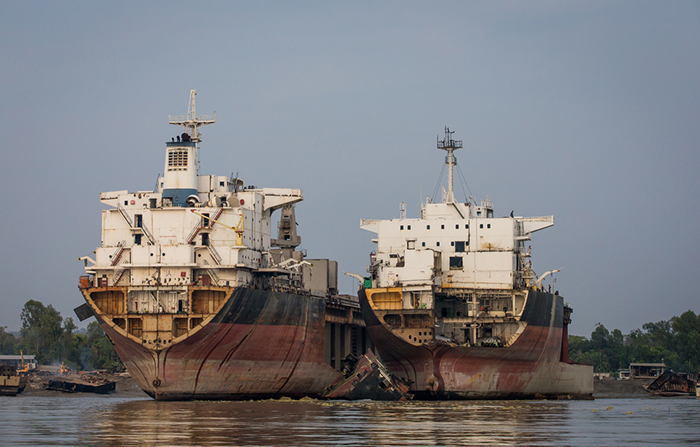 |
BIMCO increased its projection for the number of twenty-foot-equivalent
units that ship scrapping would take out of circulation this year by 150,000.
|
BIMCO has significantly increased its forecast for demolition sales of
container vessels as the market continues to suffer from substantial
overcapacity.
In a report published Tuesday, chief shipping analyst Peter Sand said
BIMCO now expects 400,000 twenty-foot-equivalent units to leave the market
through demolition sales. In January, he forecast 250,000 TEU. The figure in
2015 was about 200,000 TEUs.
The global container ship fleet now stands in excess of 20 million TEUs
while newbuildings added 85 ships with a total capacity of 598,000 TEUs by
early August. In the same period, 92 vessels totaling 303,000 TEUs exited the
market via demolition.
Demand growth has remained weak and in the first quarter rose only 0.5
percent year-over-year.
"Overall container demand grew around 2 percent in in the second
quarter compared to the second quarter of 2015. Global container demand is
struggling to achieve a GDP-to-trade multiplier of one," Sand said in the
fresh report.
"Reflecting on our last report, where BIMCO stated that demand is
not really going anywhere, we now see a development, minor and slow, but above
all positive," he said.
However, he said that tonnage would grow 8 percent in gross terms until
2018, while demolitions would only account for 3 percent of the fleet this year
and 2 percent in 2017 and 2018.
Going forward, ocean carriers will feel the pinch, in terms of price and
volume, of new and much lower contracts on the trans-Pacific that were agreed
on in May, Sand said.
"Anecdotal evidence indicates that the price offered to the largest
customers has dropped below $750 per FEU (40-foot-equivalent unit) for US West
Coast-bound containers and $1,500 per FEU for those east coast bound. These
levels reflect the poor spot market during the negotiation period," he
said.
Such low rates indicate that shippers have an upper hand in negotiating
not seen since 2009, and that carriers can fear an even worse spot market in
the coming year, Sand said.
While it is difficult to blame shippers for using the spot market to push
down contract rates, the collapse of Hanjin Shipping is a reminder that such
tactics can also lead to the roiling of international supply chains via the
failure of a major liner.
"For the full year to balance out between supply and demand growth,
we need demand to grow in the third and fourth quarters. Year-to-date the
balance has worsened. Demand has been slow, part of the idle fleet has been
reactivated and new ships have outstripped the number of ships being
demolished," Sand concluded.
While demolitions can help balance supply and demand, most of the new
vessels liners are deploying are very large, while demolitions tend to target
smaller ships. This makes it difficult for demolitions to have a direct impact
on capacity. Panamax ships for example, have seen their idle and scrap numbers
jump in the months following the opening of larger locks on the Panama Canal
that can handle ships larger than the Panamax class. Since liners are replacing
the Panamaxes with larger vessels, there is little, if any, negative impact on
overall capacity.
"The trend towards higher capacity container ships stands out during
the 2006 to 2016 period and even accelerated in the last five years. Therefore,
the driver towards the 20-million-TEU margin was ultra-large containerships and
post-Panamax between 8,000 and 12,000 TEUs," Sand stated in a report in
May this year.
As larger tonnage enters service, liners are deploying older ships on
east-west trades to various other trades, including north-south ones. The slow
growth of demand is likely complicating such efforts.
Global trade in the past grew much faster than global GDP, but after the
financial crisis that growth has slowed considerably, taking a serious toll on
shipping. Container lines have since slowed down their orders for newbuilds,
but a good deal of tonnage from these mega-ships came online in the years
following 2010.
Source: joc.com. 06 September 2016
No comments:
Post a Comment